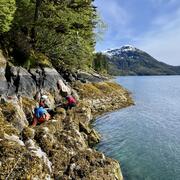Arctic
Arctic
Filter Total Items: 18
Q&A: USGS Ecosystems Provides Objective Science to Manage Lands, Fish, and Wildlife
The USGS Ecosystems Mission Area is the only program within the Department of Interior (DOI) focused on generating science to inform the management of the nation’s lands, fish, and wildlife. The Ecosystems Mission Area is also the only entity with the specific role of meeting the information needs of DOI agencies (e.g., Bureau of Land Management, Bureau of Ocean Energy Management, National Park...
The Rusting of Arctic Rivers: Freshwater Ecosystems Respond to Rapidly Uptaking Metals
The water quality of streams and rivers in the Arctic is sensitive to rapid climate change and altered disturbance regimes.
ASC Ecosystems Data Releases
Alaska Science Center Ecosystems data releases are grouped by topic: Terrestrial Ecosystems, Aquatic Ecosystems, Wildlife Health and Genetics, Environmental Health and eDNA, Habitat and Landscape Change, and Ecosystem Analytics.
Polar Bear Research
Polar bears ( Ursus maritimus) are one of 4 marine mammal species managed by the U.S. Department of Interior. The USGS Alaska Science Center leads long–term research on polar bears to inform local, state, national and international policy makers regarding conservation of the species and its habitat. Our studies, ongoing since 1985, are focused on population dynamics, health and energetics...
Walrus Research
The USGS Alaska Science Center conducts long-term research on the Pacific walrus to provide scientific information to Department of Interior management agencies and Alaska Native co-management partners. In addition, the USGS Pacific walrus research program collaborates with the U.S. Fish and Wildlife Service (USFWS) and the State of Alaska’s Department of Fish and Game and Alaska Native co...
Changing Arctic Ecosystems
Arctic regions of Alaska are important for cultural and economic sustainability and host a wide variety of wildlife species, many of which are of conservation and management interest to the U.S. Department of the Interior. The USGS and collaborators provide information about Arctic ecosystems that are used by Arctic residents, management agencies, and industry.
Polar Bear Maternal Denning
Pregnant polar bears enter maternity dens in October/November, give birth to cubs in December/January, and exit dens in March/April. Historically, most polar bears from the Southern Beaufort Sea (SBS) population constructed maternity dens on the sea ice. Over the last three decades, as sea ice has become thinner and prone to fragmentation, there has been a landward shift in the distribution of...
Terrestrial Ecosystems
The USGS conducts research on trust Department of Interior migratory bird and mammal species and their habitats to inform agencies such as the US Fish and Wildlife Service, Bureau of Land Management and National Park Service in their natural resource management decisions.
Alaska Petroleum Systems
The Alaska Petroleum Systems project has three main objectives: (A) conduct research that increases our understanding of Alaska petroleum systems, (B) conduct assessments of undiscovered oil and gas resources, and (C) deliver energy-resource information to land and resource managers, policy makers, and the public.
Beavers Impacting Tundra Ecosystems (BITE)
The range expansion of the North American beaver ( Castor canadensis) has implications for water quality, aquatic ecosystems, and fisheries in Arctic streams.
Winter Habitat of Juvenile Dolly Varden in the Canning River
In the Arctic, rivers often freeze all the way to the bottom each winter leaving fish with limited habitat where they can survive.
Biogeochemistry of glaciers
Significant change to the Arctic and sub-arctic water cycle is underway, impacting hydrologic and biogeochemical fluxes. In southcentral Alaska, glacier mass loss, changes to precipitation (including the rain/snow fraction), thawing ground ice, and vegetation encroachment will change both magnitude and timing of water and solute fluxes downstream. Although altered fluxes of limiting nutrients are...













